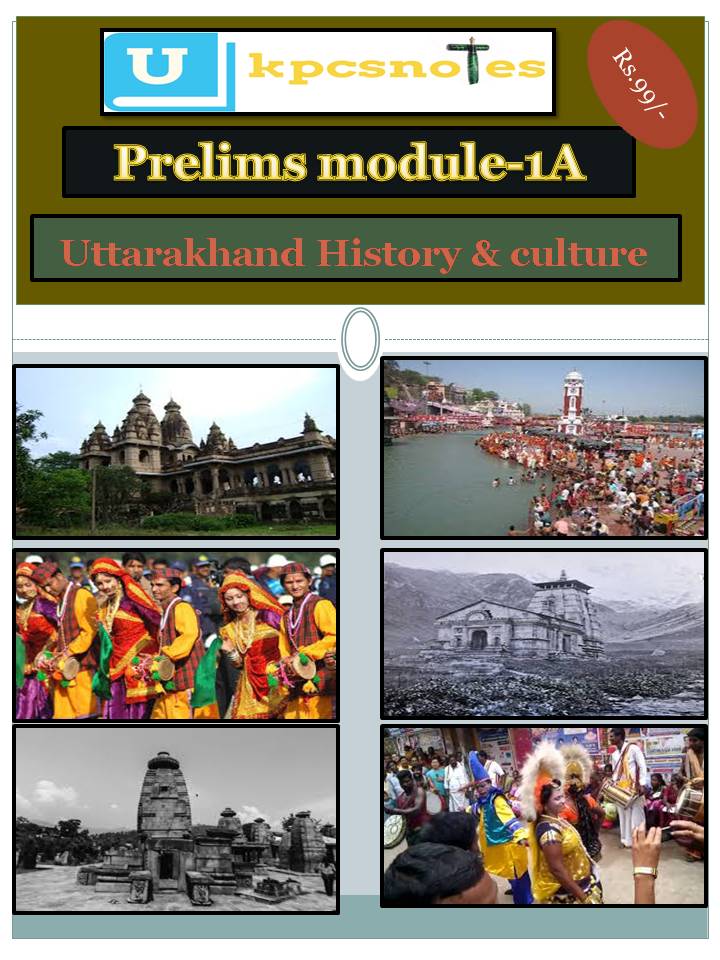Uttarakhand History can be traced back to the Prehistoric Period , with the development of Civilization in the Ancient History of Uttarakhand. We have Bifurcated the History of Uttarakhand into four sections for the systematic study for UKPCS Exam by our students.
Uttarakhand History plays a crucial role in not only Uttarakhand PSC Prelims Exam but even UKPCS Mains Exam. Uttarakhand History Notes are designed by UKPCS Toppers and other civil servants. Detail Notes can be browsed at the following links
Detailed Notes for Uttarakhand History
Specifically designed Notes for Uttarakhand History can be Bought at minimum price in PDF or Printed format
- Cultural Renaissance
- Current Challenges and Future Prospects
- Constitutional Formation of Uttarakhand
- Tribal and Marginalized Communities
- Political Evolution in Uttarakhand
- Role of Women in Modern Uttarakhand
- Tourism and Pilgrimage in Modern Times
- Natural Disasters and Recovery
- Modern Economic Development
- Demand for Statehood
- Formation of Uttarakhand State
- Environmental Movements
- Integration into the Indian Union
- Post-Independence Development
- Social Movements Post-Independence
- Development of Modern Education
- Tehri Garhwal State and Its Role
- Partition and Post-Independence Changes
- Cultural Revival and Reform Movements
- Role in Indian Freedom Struggle
- Peasant Movements
- Forest Rights Movements
- British Colonial Administration
- Socio-Economic Changes Under British Rule
- Impact of Forest Policies
- Continuity of Traditions
- Archaeological Discoveries
- Early British Contact and Influence
- Relations with Neighboring Kingdoms
- Decline of Medieval Dynasties
- Emergence of British Influence
- Development of Literature and Folklore
- Pilgrimage and Religious Centers
- Environmental and Geographical Influence
- Economy and Trade in Medieval Uttarakhand
- Society and Caste Dynamics
- Art and Architecture
- Cultural and Religious Flourishing
- Islamic Influence in Medieval Uttarakhand
- Conflict and Warfare
Hope you must have Liked the detailed Notes for UKPCS Preparation by Uttarakhand PSC Notes expert team. Free notes for UKPCS can be browsed on UKPCSnotes.
For any querry and suggessions kindly leave a comment in the below comment box for expert guidence by UKPCS Experts.
FAQs on History and Culture of Uttarakhand
What are the ancient names of Uttarakhand?
Uttarakhand was known by various names in ancient texts:
- Kedarkhand: Referred to the Garhwal region.
- Manaskhand: Referred to the Kumaon region.
- Devabhumi: “Land of the Gods,” referencing the numerous religious sites and mythological significance.
Which dynasties ruled Uttarakhand in ancient and medieval times?
Several dynasties have ruled Uttarakhand throughout history:
- Kuninda Kingdom: (2nd century BCE to 3rd century CE) An ancient Himalayan kingdom.
- Katyuri Dynasty: (7th to 11th centuries CE) Ruled over Kumaon and Garhwal.
- Chand Dynasty: (10th to 18th centuries CE) The most prominent dynasty, ruling Kumaon.
- Panwar Dynasty: (9th to 19th centuries CE) Ruled over Garhwal.
How did the British influence Uttarakhand’s history?
A3: The British gained control of Kumaon and Garhwal in the early 19th century after the Anglo-Nepalese War. They established administrative systems and infrastructure, leaving a lasting impact on the region.
When did Uttarakhand become a separate state?
Uttarakhand was carved out of Uttar Pradesh and became a separate state on November 9, 2000.
What are the major languages spoken in Uttarakhand?
A1: The main languages spoken in Uttarakhand are:
- Garhwali: Spoken in the Garhwal region.
- Kumaoni: Spoken in the Kumaon region.
- Hindi: The official language of the state.
What are the main festivals celebrated in Uttarakhand?
Uttarakhand has a rich tradition of festivals, some of the most popular ones include:
- Kumbh Mela: A major Hindu pilgrimage held every 12 years in Haridwar.
- Phool Dei: A spring festival celebrating the blossoming of flowers.
- Bhitauli: A festival honoring brothers and sisters.
- Ganga Dussehra: Celebrating the descent of the River Ganges to Earth.
- Nanda Devi Raj Jat Yatra: A long pilgrimage in honor of the goddess Nanda Devi.
What is the traditional attire of Uttarakhand?
Traditional attire varies across regions:
- Garhwali: Men wear dhoti, kurta, and topi (cap), while women wear ghagra (long skirt), choli (blouse), and odhni (veil).
- Kumaoni: Similar to Garhwali attire, with some regional variations.
What are some famous folk dances of Uttarakhand?
Uttarakhand has a rich folk dance tradition, some popular dances include:
- Barada Nati: A dance of the Jaunsar-Bawar region.
- Langvir Nritya: An acrobatic dance performed by men.
- Pandav Nritya: A dance narrating the epic Mahabharata.
- Chholiya: A sword dance performed during festivals.
What are the main architectural styles found in Uttarakhand?
Uttarakhand’s architecture reflects its history and cultural influences. Some notable styles include:
- Katyuri style: Temples with intricate carvings and sculptures.
- Chand style: Palaces and forts with elaborate designs.
- Colonial style: Buildings constructed during the British Raj.
- Traditional houses: Built using local materials like stone and wood.
